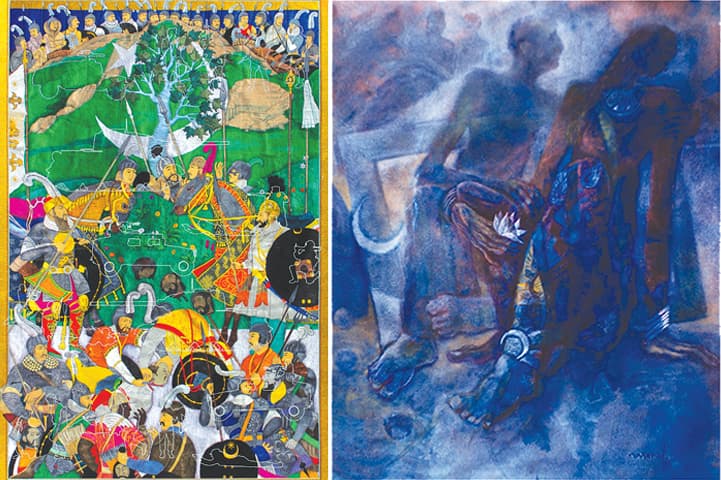
As part of the recently held Pakhtun Festival, organised by Cultoor and held at the Pakistan National Council of Arts (PNCA), artworks from a group of 10 artists were displayed in an exhibition titled Sulah. Curated by Alia Bilgrami, an independent curator and visual artist, the show echoed the tragedy of displacement and how turmoil passes on from one generation to the next. The works in Sulah — a title which translates to reconciliation in both Urdu and Pashto — are connected both visually and through the rich cultural history and identity shared by the participating artists. During a one-on-one interview, Bilgrami recalled the levels she went through to find the perfect artworks to exhibit with regard to the premise of the show, thereby ensuring a successful dialogue, and included artists of Pakhtun, Hazara and Baloch descent.
As the title suggests, the show aimed at bridging the gap between these artists and their cultural identity that has been in constant upheaval as a result of political strife. The artists, emerging and established in their respective practices, were from both Afghanistan and Pakistan and from cities such as Swat, Quetta and Kabul.
Two artists tackled the issues of suppression of women. A sound and visual installation was displayed by Afghan artist Malina Suliman. The installation included burqas hung on the wall and on either side of the fabric, speakers played recordings of spoken wishes by Afghan and Dutch women. Each burqa was specifically chosen as it was hand-stitched by the women who wore it and became a symbol for these women. The juxtaposition of the burqa and recordings accentuated the display as one was allowed to see the ‘cage’ but at the same time hear the longing for freedom.
An exhibition titled Sulah brings together hugely talented artists belonging to the Pakhtun community
Peshawar-born Ayesha Durrani in her elegant miniature pieces, painted with gold leaf, subtly celebrates women who withstand daily oppression, Another Afghan artist, Ali Baba Awrang, brought calligraphy to the display which has been an important art in the South Asian region for centuries. His style, however, augments the traditional craft and creates whirls of abstract pieces that are expressionistic in nature. As part of the marginalised Hazara community, Awrang has first-hand experience of the violence in a war-torn city.
Another artist from the Hazara community, Khadim Ali, is originally from Quetta. Influenced by the epic Shahnama (The Book of Kings), he creates intricate miniature paintings that reflect the celebrated story but, at the same time, respond to the despondency of the present. For Sulah, along with Ali’s paintings, a magnificent tapestry from his ‘Otherness’ series was also displayed, creating an immediate connection to the West where this form of art was used to depict scenes of war and other events for centuries. The woven fabric brilliantly follows the flattened perspective of traditional miniature while also having fine white outlines of modern war machinery subtly overlapping the visual.
Also born in Quetta is artist Mubarak Shah, who was the only sculptor in the show. His distorted terracotta pieces, while retaining their anthropomorphic quality, invited the audience to engage personally with them.

Shahaan Shah is another native of Quetta and a recent graduate of the National College of Arts (NCA), Rawalpindi. As a textile design major, the artist brings forth his use of organic material and his presence brought a variety in terms of the age group, giving the show a holistic feel.
An up-and-coming artist Sadam Khan Murad, whose palette bore a striking resemblance to his father Murad Khan’s, was also impressive. Living in Swat, the father-son duo draw their earthy tones from the Gandhara ruins. While the father presents a further connection to the space with his imagery, the son brings forth contemporary visuals. The two are great examples of how cultural identity and heritage is passed through generations.
Prints by Muhammad Atif Khan transcend time and space as Mughal figures interact with kites, bridges and other contemporary imagery.
Sajid Khan reminiscences about the sublime beauty of Malakand — a once vibrant landscape which was badly damaged during anti-insurgency operations — which he depicts in his work. The show was greatly successful in keeping to the premise of the theme and displayed the curator’s commitment. It also took into consideration that culture, though evolving, exists in its original form to some extent in each generation and provided a holistic view with its addition of emerging talent.
“Sulah” was displayed at the main gallery of the Pakistan National Council of Art, Islamabad and ran in tandem to the Pakhtun Festival organised by Cultoor from March 30 to April 12, 2018
Published in Dawn, EOS, May 6th, 2018















































Dear visitor, the comments section is undergoing an overhaul and will return soon.